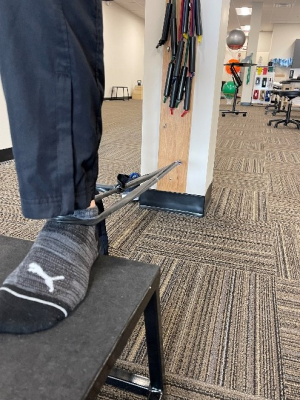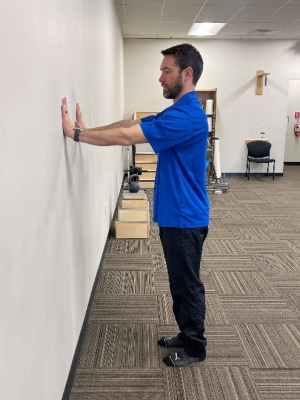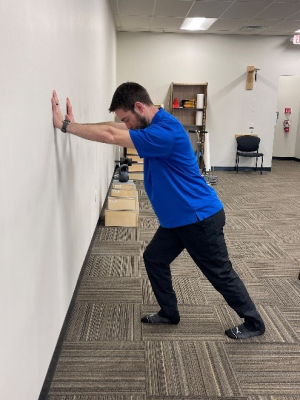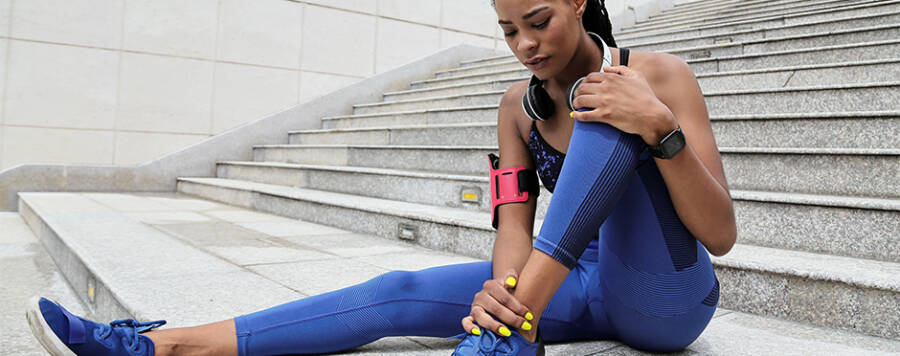Plantarflexion is when the foot moves down and away from the shin, similar to standing on your toes or pressing a brake pedal. Dorsiflexion is when the foot moves up toward the shin, such as tapping your toes or lifting your foot off the brake.
As a physical therapist, I often see patients with running injuries who have limited ankle dorsiflexion. Typically, our ankles can dorsiflex about 10 to 20 degrees beyond a neutral position7. Limited dorsiflexion can hurt your running performance, but stretching and mobilizing the ankle can help improve this range of motion3,5,6. Below, I’ll show you how to assess your ankle dorsiflexion and provide techniques to stretch and mobilize for better movement.
Ankle Dorsiflexion Quick Test


Remove your shoe and stand with your toes 3-4 inches from the wall. Keeping your heel planted on the ground, lean forward so your knee approaches the wall. The goal is to touch the wall with your heel remaining on the floor.
Did you touch the wall with your heel planted? Congratulations! Your ankle dorsiflexion mobility is likely appropriate for running. Did your heel rise, or could you not touch your knee to the wall? See the methods below!
Ankle Dorsiflexion Mobilization


Attach a thin elastic band behind you, then step through the loop. The band should be below the level of the malleoli (the two bony bumps on the outside of your ankle). Step your foot onto an elevated surface. Lean forward so your knee tracks above your toes, ensuring your heel stays planted. Repeat in a slow, controlled manner for 30-60 seconds.
Wall Ankle Stretch


Stand an arm’s length away from the wall. Step your affected leg back, with your toes pointing straight at the wall. Lean forward towards the wall, making sure your heel stays planted. Hold for 30-60 seconds.
Ankle Stretch on Incline board

Look for a sturdy incline board near a wall to hold onto for balance. If you don’t have an incline board, you can place small weights under the front of a board to make a slope. Keep your toes pointed forward and your knees straight and maintain a forward lean. Hold this forward lean for 30-60 seconds.
If you try these ankle methods and are still experiencing running injuries, contact your nearest Athletico location for a free assessment. One of our movement experts will assess your current condition, answer your questions, and provide expert recommendations for the best next steps to help you get back on track.
*Per federal guidelines, beneficiaries of plans such as Medicare, Medicaid, Tricare, VHA and other federally funded plans are not eligible for free assessments.
*All exercises create some risk of injury or other adverse events. A physical therapist can personalize your exercise regimen and help mitigate some of these risks. Prior to starting a new exercise regimen consult a physical therapist or other qualified healthcare professional if you have ever experienced heart, circulatory problems, blood pressure, breathing, joint, or movement problems, decreased balance, feelings of dizziness, back pain, prolonged headaches or migraines, diabetes, or asthma, or if you are on prescription medications, recently completed a course of medications, recently had surgery, are pregnant or recently gave birth, or if your healthcare provider has advised against these types of exercise.
References:
1. Front foot strike leads to higher force through the foot and ankle
– (Xu Y, Yuan P, Wang R, Wang D, Liu J, Zhou H. Effects of Foot Strike Techniques on Running Biomechanics: A Systematic Review and Meta-analysis. Sports Health. 2021 Jan/Feb;13(1):71-77. doi: 10.1177/1941738120934715. Epub 2020 Aug 19. PMID: 32813597; PMCID: PMC7734358.)
2. Knee pain (patellofemoral syndrome or IT band pain syndrome), shin pain (Medial Tibial stress syndrome “shin splints”) and ankle (Achilles tendinopathy) or foot (plantar fasciitis) are most common running injuries.
– Lopes AD, Hespanhol Júnior LC, Yeung SS, Costa LO. What are the main running-related musculoskeletal injuries? A Systematic Review. Sports Med. 2012 Oct 1;42(10):891-905. doi: 10.1007/BF03262301. PMID: 22827721; PMCID: PMC4269925.
3. Stiff ankles can actually be a cause of knee pain
– Lima YL, Ferreira VMLM, de Paula Lima PO, Bezerra MA, de Oliveira RR, Almeida GPL. The association of ankle dorsiflexion and dynamic knee valgus: A systematic review and meta-analysis. Phys Ther Sport. 2018 Jan;29:61-69. doi: 10.1016/j.ptsp.2017.07.003. Epub 2017 Jul 19. PMID: 28974358.
4. Incline board more effective than wall stretching
– Kim TH, Lim OK, Park KD, Lee JK. Comparison of Two Static Stretching Techniques for the Triceps Surae in Healthy Individuals: Wall and Inclined Board Stretchings. Ann Rehabil Med. 2020 Apr;44(2):125-130. doi: 10.5535/arm.2020.44.2.125. Epub 2020 Apr 29. PMID: 32392651; PMCID: PMC7214133.
5. Static stretching can improve ankle dorsiflexion
– Radford JA, Burns J, Buchbinder R, Landorf KB, Cook C. Does stretching increase ankle dorsiflexion range of motion? A systematic review. Br J Sports Med. 2006 Oct;40(10):870-5; discussion 875. doi: 10.1136/bjsm.2006.029348. Epub 2006 Aug 22. PMID: 16926259; PMCID: PMC2465055.
6. Static stretching is effective at improving ankle dorsiflexion ROM
– Medeiros DM, Martini TF. Chronic effect of different types of stretching on ankle dorsiflexion range of motion: Systematic review and meta-analysis. Foot (Edinb). 2018 Mar;34:28-35. doi: 10.1016/j.foot.2017.09.006. Epub 2017 Oct 27. PMID: 29223884.
7. Normal ankle ROM
– Brockett CL, Chapman GJ. Biomechanics of the ankle. Orthop Trauma. 2016 Jun;30(3):232-238. doi: 10.1016/j.mporth.2016.04.015. PMID: 27594929; PMCID: PMC4994968

 width="900"
height="356"
>
width="900"
height="356"
>

1 Comment
Mike Rezac
Definitely sending this to a friend who is a runner!
Excellent tips.